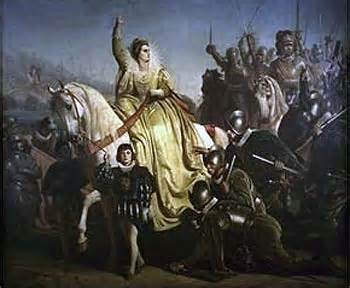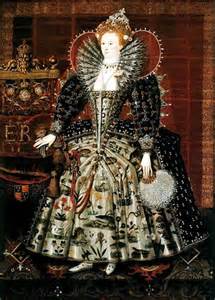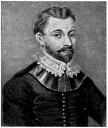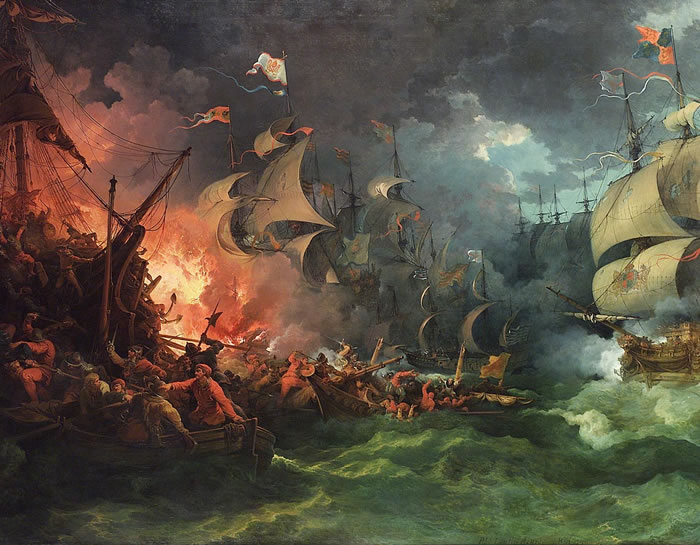The Grand Failure of the Spanish Armada
The Spanish Armada was a huge attack force of ships and men from Spain launched against England in 1588. A series of events, including freak storms and creative English battle tactics, resulted in the defeat of the Armada. England and Spain were at war in all but name in the 1580s, over power and influence in the political and religious realms. Both countries were striving for dominance in trade among European nations and among those nations' colonies. Both countries were also on either side of a religious divide. England's King Henry VIII had declared his country separate from the Roman Catholic Church in 1531. Henry was proclaimed the head of the newly created Church of England. When Henry died in 1547, his son became King Edward VI and ruled as head of the Church of England. Edward's death six years later brought his sister Mary to the throne. Mary wanted to return England to the Catholic religion and began punishing people who didn't profess to the Catholic faith. This effort was bolstered by Mary's marriage to Spain's King Philip II. The two ruled England together from 1553 to 1558, when Mary died.
During this time, Elizabeth had also made it known that she supported a Protestant revolt against Spain in what was then called the Spanish Netherlands. Part of that country (basically modern-day Holland) had declared itself independent from Spain, with English support, and Philip had another reason to want Elizabeth off the English throne. As it happened, war between the Netherlands and Spain had begun in 1568. With the full support of the pope, Sixtus V, Philip amassed a great fleet of ships and filled them with soldiers. In all, 151 ships sailed for Spain against England. Aboard these ships were 18,000 soldiers, 8,000 soldiers, and 250 large guns. The fleet was so large that it took two days (May 28 and 29) to leave port at Lisbon, in what is now Portugal. Commanding the armada was the Duke of Medina Sidonia, a nobleman with no previous sea experience. The armada's intended commander, the highly experienced Alvaro de Bazan, had died a few months before.
The plan was for the armada to sail up the Atlantic coast of Europe and then to Spanish-controlled Netherlands (basically modern-day Belgium), where 30,000 soldiers waited to board. Bad weather kept the Spanish fleet adrift for a few weeks. English scouts saw the armada on July 19, off the coast of Cornwall, which is on the southwest corner of England. Through a series of beacons, word spread from Cornwall to London, all along the south coast, that the armada had arrived.
The English fleet was actually larger than the Spanish fleet. About 200 English ships harried the ships of the armada. The English ships were also faster and more maneuverable than their Spanish counterparts. English captains kept themselves out of range of the Spanish grappling hooks, meaning that the thousands of Spanish soldiers onboard the armada's ships could not be brought to bear in the fighting. However, the Spanish ships were far enough away from the English cannons that many of the cannonballs fell harmlessly in the sea. A few days later, the fleets clashed again. The maneuverability of the English ships proved decisive, and the Spanish fleet retreated to Calais, in France. Meanwhile, the 30,000 troops waiting to become part of the armada's fighting force had made their way westward, to Dunkirk, in France. A combination of disease and poor traveling conditions had cut this fighting force nearly in half, so that only 16,000 remained. A group of English ships successfully kept this army on land by keeping Spanish ships away from Dunkirk. On the night of July 28, the English fleet unleashed its deadliest salvo, fire ships. English sailors packed eight ships full of pitch, brimstone, and gunpowder and set the ships alight. Spanish sailors intercepted two of the eight ships and towed them out of the way, but the remaining six created enough confusion that the Spanish ships were not at all prepared for the ensuing English attack. The following day, July 29, was the climactic battle, although the fighting wasn't over yet.
Despite all of this, the threat of invasion still loomed. Queen Elizabeth took the threat seriously enough to don armor herself and right to Tilbury, in the southeast, to rally the scant number of soldiers garrisoned there. She gave a famous speech to the troops on August 9. 
"My loving people, The armada, however, was by that point headed for home, the long way. After the failure of the meetup with troops from the Spanish Netherlands, the multiple engagements with the speedier English ships, and the dreaded fire ships attack, the Duke of Medina Sidonia had seen enough. Because of weather patterns, the Spanish ships were forces to sail north along England's eastern coast and then around the top of the island, tacking down around Ireland and into the North Atlantic on the trip back to Spain. A further set of storms added to the list of overall casualties. Because so many of the Spanish ships had abandoned their anchors in an attempt to avoid the English fire ships, many ships in the reduced armada were unable to stop their gale-driven progress and were ground onto the rocks of Ireland. Earlier, the Spanish fleet had discovered a large amount of rotten food and water onboard. A large number of barrels containing food and water were made of still-wet wood (constructed in a hurry), and the wood had rotted, ruining the food and water. This had an even greater effect during the sail home, as some sailors resorted to eating rope to survive. The number of Spanish ships that returned was 67. Fewer than 10,000 Spanish men returned. English losses were fewer than 100 dead and no ships sunk. (More than 7,000 English sailors died from disease, however.) The failure of the Spanish Armada was nowhere near the end of the struggle between England and Spain. The unofficial war dragged on for a few decades, but the fighting was, in that war at least, not again as strong as it was. England reigned ascendant on the high seas and on land, solidifying Elizabeth's hold on Protestant Netherlands. Spain's defeat resulted in a combination of an economic downturn and an increase in taxation. |
|
Social Studies for Kids
copyright 2002–2025
David White



 Henry's daughter Elizabeth
Henry's daughter Elizabeth  One of the famous sea captains for the English side was
One of the famous sea captains for the English side was  Bad weather had the English fleet trapped in Plymouth harbor that night, but the Spanish did not attack. Instead, the Spanish ships sailed on. On July 21, the two forces collided.
Bad weather had the English fleet trapped in Plymouth harbor that night, but the Spanish did not attack. Instead, the Spanish ships sailed on. On July 21, the two forces collided.  Spanish firepower overall was one-and-one-half times that of the English. However, English captains were able to take advantage of Spanish war practices by staying out of range of the initial barrage and then closing in for a devastating counter-attack. This strategy effectively counteracted Spain's preference for closing-and-boarding as well. Again, the superior Spanish manpower could not be brought to bear. An extreme example of this was the unusually high number of "effective" shots fired by English ship guns, which incapacitated Spanish gunners and forced ordinary (untrained) foot soldiers into position manning the huge Spanish guns. So even though the Spanish had more firepower, they were not able to press this advantage, either.
Spanish firepower overall was one-and-one-half times that of the English. However, English captains were able to take advantage of Spanish war practices by staying out of range of the initial barrage and then closing in for a devastating counter-attack. This strategy effectively counteracted Spain's preference for closing-and-boarding as well. Again, the superior Spanish manpower could not be brought to bear. An extreme example of this was the unusually high number of "effective" shots fired by English ship guns, which incapacitated Spanish gunners and forced ordinary (untrained) foot soldiers into position manning the huge Spanish guns. So even though the Spanish had more firepower, they were not able to press this advantage, either.
